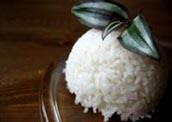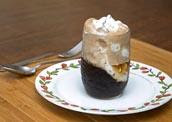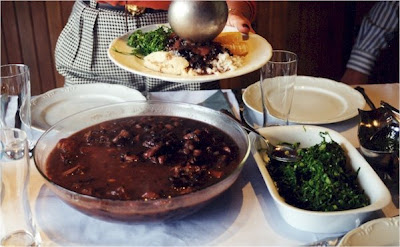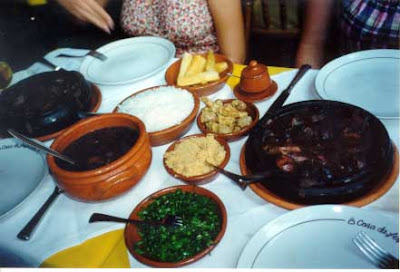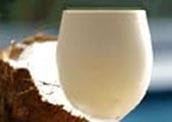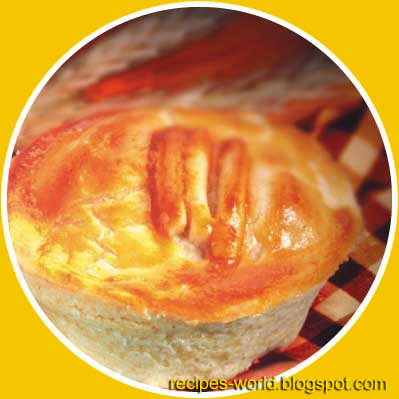Beijing Duck or Beijing Roast DuckBeijing Roast duck is thought to be one of the most delicious dishes all over the world; most visitors coming to Beijing will never forget to have a try. Eating Peking duck is seen to be one of the two things you are absolutely supposed to do while in Beijing.
 Beijing duck Ingredients:
Beijing duck Ingredients:One 5 to 6 pound duck
8 cups water
1 slice ginger
1 scallion, cut into halves
3 tablespoons honey
1 tablespoon white vinegar
1 tablespoon sherry
1 1/2 tablespoons cornstarch, dissolved in 3 tablespoons water
Scallions for garnish
Directions:Clean duck. Wipe dry and tie string around neck.
Hang duck in cool, windy place 4 hours.
Fill large wok with water. Bring to boil. Add ginger, scallion, honey, vinegar, and sherry. Bring to boil. Pour in dissolved cornstarch. Stir constantly.
Place duck in large strainer above larger bowl. Scoop boiling mixture all over duck for about 10 minutes.
Hang duck again in cool, windy place for 6 hours until thoroughly dry.
Place duck breast side up on a greased rack in oven preheated to 350 degrees. Set a pan filled with 2 inches of water in bottom of oven. (This is for drippings). Roast 30 minutes.
Turn duck and roast 30 minutes more.
Turn breast side up again. Roast 10 minutes more.
Use sharp knife to cut off crispy skin. Serve meat and skin immediately on a prewarmed dish.
The duck is eaten hot with hoisin sauce rolled in Mandarin Crepes. Garnish with scallion flowerets.
 How to eat it?
How to eat it?First, the chef will show you the whole duck. Then, he will slice it into about one hundred and twenty pieces with both skin and meat for each. Usually the duck is served together with special pancakes, hollowed sesame bun, green onions and sweet sauce.
There is a proper way to eat it. First, pick up a slice of duck with the help of a pair of chopsticks and dip it into the soy paste. Next, lay it on the top of a thin cake and add some bars of cucumber and shallot. Finally, wrap the stuff into a bundle with the sheet cake (a thin pancake). The real secret of Peking duck's flavor lies in your carefully nibbling away at the mixture. You will find all the different ingredients very compatible. People say: "it's a pity to leave Beijing without trying the roast duck The taste of the roast duck is in the eating.
 How roast duck was made?
How roast duck was made?You might want to know more about how Peking Roasted Duck is made. The ducks are raised for the sole purpose of making the food. Force-fed, they are kept in cages which restrain them from moving about, so as to fatten them up and make the meat comparably tender.
Special farms supply plump Beijing ducks weighing an average of 2.5 kilograms each. The two famous Beijing condiment shops, Liubiju and Tianyuan, supply the dark tangy bean sauce spread on the pancakes. The fragrant sesame oil and refined sugar are also specially selected. Finally, only the wood of fruit trees such as date, peach and pear are used in the roasting process to give the meat its unique fragrance.
Select a duck with whole skin. First the ducks are rubbed with spices, salt and sugar, and then kept hung in the air for some time. Cuts open the belly and draw, and then insert a 2 inch long piece of wood to support the chest bone and to stretch the skin. Hook the duck by the neck, spread diluted maltose over it. Hang the duck in an airy place to dry.
The stuffed duck is hung in the roaster and kettles of hot water are placed in front to fill out the duck. Proper timing and temperature are important and the duck is turned often enough to roast them completely and evenly. (Try 350°F turn every 15 minutes, total roasting time about 40 minutes). Roast until golden brown with rich grease perspiring outside and have a nice odor.
What is Beijing Duck Recipe?Normally there are many dishes served with the duck, including a dish of fine-cut shallot bars, a dish of cucumber bars and finally a dish of paste-like soy of fermented wheat flour. It is not necessary to order extra soup, for the duck-bone soup is always included in you order. It will be served as the rear dish for the dinner.
History of Roast DuckThe art of roasting ducks evolved from techniques used to prepare sucking pigs.
The history of the roast duck can be traced back to as early as the Yuan Dynasty (1206-1368) when it was listed among the imperial dishes in the Complete Recipes for Dishes and Beverages, written in 1330 by Hu Sihui, an inspector of the imperial kitchen. Details regarding the cooking process were also described in this early cookbook.
In the early 15th century, when the Ming Dynasty capital was shifted from Nanjing to Beijing, roast duck remained one of the famous dishes on imperial court menus. According to the local history, the earliest roast duck restaurant in Beijing was the old Bianyifang Restaurant, which opened during the Jiajing reign (1522-1566). Distinct from the method in which the duck is hung from a hook in the ceiling of the oven and roasted over and roasted over burning wood, the Old Bianyifang Restaurant roasted its ducks with radiant heat. The walls of the oven were first heated with sorghum stalks whereupon the duck was placed inside and cooked by the heat given off by the walls. A duck roasted in this manner is crisp to the touch and golden brown in appearance; its flesh is both tender and tasty.
During the Qianlong period (1736-1796), roast duck was a favorite delicacy of the upper classes. According to Recipes from the Suiyuan Garden, the famous cookbook written by the poet and gourmet Yuan Mei, "Roast duck is prepared by revolving a young duckling on a spit in an oven. The chefs of Inspector Feng's family excel in preparing this dish." Other scholars, after dining on roast duck, were inspired to poetry. In one collection of old Beijing rhymes (Duan Zhuzhici) one of the poems reads: "Fill your plates with roast duck and suckling pig." Another contemporary annotation reads: "When an official gives a banquet he will choose dishes to please each of his guests. For example, Bianyifang's roast duck…"
To satisfy the growing demand for roast duck, and with an eye on the profits to be made from a good name, many restaurants opened from a good name, many restaurants opened under the Bianyifang name. In fact, in 1926, nine roast duck restaurants in Beijing carried this name. In the late 1960s the Bianyifang Restaurant's name was changed to the Chongwenmen Roast Duck Restaurant, but in 1979 it resumed its former title. Its menu includes more than 20 traditional duck dishes, including the Four Delicacies: wing and web, liver, heart and pancreas.
 Which restaurant is famous one?
Which restaurant is famous one?The two famous restaurants that serve Beijing Roast Duck are Bianyifang Roast Duck Restaurant and Quanjude Roast Duck Restaurant, both of which have a history of over one hundred years. They represent two different schools of roasting duck. Bianyifang, founded in 1855, makes use of a close oven and straw as the fuel, which won't make flames go directly onto the duck. Before being put into the oven, a duck is filled with specially-made soup to make it possible to roast the duck outside and boil it inside at the same time.
Quanjude, a better known one, founded in 1864, uses an oven without a door. After a kind of dressing being spread all over a duck, it will be hooked up in the oven over the flame coming directly from the burning of the fruit-tree wood and it will be done in forty minutes. When roasted and dried, the duck will look brilliantly dark red, shining with oil and with crisp skin and tender meat. Because of its appearance, few people could resist the temptation of it.
The first restaurant to bear the name Quanjude opened in 1864 during the reign of the Qing Emperor Tongzhi. Due to its high standards, the restaurant's fame spread rapidly and for many years the supply of roast ducks could hardly satisfy the demand. For this reason, the restaurant was rebuilt and expanded in 1948. In 1954 a branch (known as Hongbinlou) was opened in West Chang' an Boulevard and another in Wangfujing Street in 1959. These additions, however, still did not solve the problem, and with the opening of the Quanjude at hepingmen in 1979, it was no longer necessary to make a reservation a week in advance to taste Beijing's most famous culinary delight.
